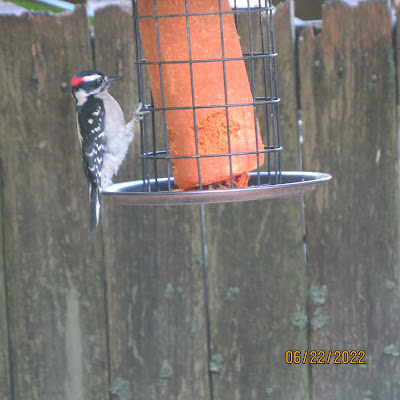For the Birds: Fall is Here
Friday, November 8, 2024
Fall is here. Gone are the summer birds. Not until spring will we delight in the songs of the migrating Yellow-rumped Warblers, nor catch the passing notes of the Pacific Slope Flycatchers.
Snow geese are just starting to arrive from Wrangel Island off the Siberian coast and will stay in Washington until sometime in April. The Skagit and Frazer deltas with their farmed fields and the native bulrushes support the largest flocks on the West Coast.
Shorebirds like the Black Turnstone should be showing up soon to winter here until they leave in April for their Alaskan breeding grounds.
 |
| Hairy Woodpecker note her bill is as long as the width of its head |
Homeowners with enough native plants and trees generally have these lovely birds until early May. It may surprise you that both species can often be found in Himalayan Blackberry with its sheltering habitat, leftover fruits and bug meals.
One of the many delights of living in an area with large trees is that we have five species of woodpeckers here:
Pileated—the largest, most vocal, and impressive with its dramatic red crest;
Hairy—reasonably common, medium sized with a bill the same length as the width of its head
Downy—diminutive, not much larger than Black-capped Chickadees, with a short bill.
Northern Flicker—smaller than the Pileated, also vocal, especial during breeding season, unusual in that it not black, but has a pleasantly varied-colored plumage.
Red-breasted Sapsucker—not very common. It prefers cottonwoods for nesting with its softer wood.
Keep liquid water all year long—birdbath heaters that come on when it's cold are available and will provide much need liquid during freezing temperatures.
Suet will provide quick needed energy. I keep my feeders dry by having baffles over them, and I watch for spoiled seed which I promptly throw away.
Previous For the Birds articles here
One of the many delights of living in an area with large trees is that we have five species of woodpeckers here:
Pileated—the largest, most vocal, and impressive with its dramatic red crest;
Hairy—reasonably common, medium sized with a bill the same length as the width of its head
Downy—diminutive, not much larger than Black-capped Chickadees, with a short bill.
 |
| Downy Woodpecker note how small he is and how short his bill |
Red-breasted Sapsucker—not very common. It prefers cottonwoods for nesting with its softer wood.
These are the woodpeckers that leave a series of small shallow holes in the bark of trees.
They like the energy content of the sap, and other birds, including Anna’s Hummingbirds, will partake in this quick often buggy treat.
Song Sparrows, Spotted Towhees, Black-capped and Chestnut-backed Chickadees are year-round residents.
Song Sparrows, Spotted Towhees, Black-capped and Chestnut-backed Chickadees are year-round residents.
Anna Hummingbirds have become year-round residents, and some Townsend’s Warblers now stay through the winters.
 |
| Red-breasted Sapsucker note the shallow sap holes it has drilled |
Suet will provide quick needed energy. I keep my feeders dry by having baffles over them, and I watch for spoiled seed which I promptly throw away.
Previous For the Birds articles here





1 comments:
we've started smearing red pepper all over the suet we hang for the birds - it seems rats and squirrels can get to it anywhere but capsaicin dissuades them.
Post a Comment